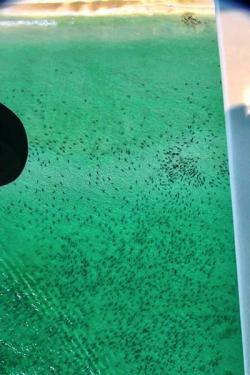Florida Shark Migrations
from The Fishing Wire
The sharks are swarming off the east coast of Florida again, providing the usual titillating footage for news helicopters who delight in showing this “dangerous” phenomenon of literally thousands of the big predators massed in an annual migration.
Though it looks like a swarm of insects, this is actually an aerial shot of thousands of sharks migrating off the beaches of Florida’s East Coast in spring. (Photo Credit Stephen Kajiura, Florida Atlantic University)To experienced coastal anglers, the migration is of interest not because it means the sharks are on the hunt for human flesh, but because when the sharks come, that means the gamefish have come as well. The whole migration goes north in spring, typically late March through mid-April, and south in fall, spanning late October and early November. The movement depends on water temperature, and on the baitfish that follow the temperature curves.
The baitfish–mullet, menhaden, sardines, cigar minnows, thread herring and more–come in unimaginable numbers, absolute masses that can cover the ocean for hundreds of acres at times, and close on their heels will be bonito, Spanish mackerel, king mackerel, cobia and an assortment of other camp followers, and weaving in and out of the gamefish are the pods of sharks, which eat both the larger bait and the gamefish.
Snook and tarpon, not so often thought of as migratory species, also migrate with the bait, though the snook apparently remain within a few miles of their home inlet and the tarpon rarely get anywhere north of the Carolinas.
All of this migrating and eating suggests two things to seasoned observers–first, right now is a VERY good time to go fishing on the east coast of Florida. And second, this is not a great time to be surfing or swimming there, particularly where the bait and the sharks are thickest.
Florida’s east coast, particularly the slightly murky waters north of Cape Canaveral, often have the highest number of shark “attacks” in the nation, though these attacks are usually no more than a quick bite that, though assuredly traumatic, is not life threatening. (Not to make light–Even an accidental shark bite can be gruesome, requiring many stitches.)
There are two reasons for this–first, the sharks that prowl close inshore are usually are spinners and blacktips, not the bigger species like the bulls and hammerheads, and secondly, all of the sharks that are in the surf zone are there to eat baitfish, not people. The murky water can make it difficult to tell bait from a flashing hand or foot, and most experts think this is the cause of most bites.
Incredibly, some tourists have been recorded standing in chest deep water with hundreds of mullet showering around them as sharks attack the bait. The wonder is not that some humans are bitten, but that more are not. (Sharks are not the only biters in the surf–a few years back a school of jumbo bluefish chased bait in among the swimmers along a South Florida beach and chomped two of them in the legs during the feeding frenzy.)
Surfers have a similarly cavalier attitude–if the waves turn up strong, they go paddling outside the break line–right where the majority of the larger sharks are chasing the gamefish and the larger bait. Not surprisingly, surfers here get bitten with some frequency relative to their small numbers compared to the number of swimmers just off the beaches.
Even at that, the number of shark bites is very low, and as the researchers frequently tell us, the odds of being struck by lightning on the beach are actually considerably greater than of being bitten by a shark. But clearly, during these few weeks when the parade of bait, gamefish and shark is at its spring peak, it’s not a great idea to go plunging deep into Florida’s east coast surf.
